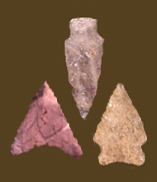|
MIDDLE PALEO POINT
Defining Attributes

The Middle Paleo point is characterized by pronounced flutes and a concave base, and is generally shorter and thinner than the preceding, but similar, Clovis point.
.jpg)
Chronology
The Middle Paleo point dates to the Paeloindian period. The accepted age range, between the Clovis and Hardaway-Dalton types, places it at roughly 10,850 to 10,550 BC (calendar years) in the mid-Atlantic region. There are no radiocarbon dates for the type.
Description
The Middle Paleo point has never been formally defined, but it has been described (Gardner 1974; Gardner and Verrey 1979). Like the Clovis, Middle Paleo points have lateral and basal grinding, and lateral pressure flake retouching. However, Middle Paleo points differ from Clovis in that the former are generally smaller and thinner, have more pronounced flutes, deeper basal concavity, and greater use of pressure flaking. There also may have been technological differences in the way the two points were produced. At the Cactus Hill site in Virginia, McAvoy and McAvoy (1997) identified four sub-types among the possible Middle Paleo points found there. They differed in traits such as size, blade shape, and the presence or absence of a waisted basal section.
A survey of fluted points in Maryland identified 14 Middle Paleo points. Their length ranged from 23.8 to 46.2 mm, with a mean of 35.66 mm and a standard deviation of 7.18 mm. Widths were between 16.4 and 28.6 mm, with a mean of 22.4 mm and a standard deviation of 3.07 mm. Thickness ranged from 4.6 to 6.7 mm, with a mean of 5.75 mm and a standard deviation of 0.55 mm. The length-to-width ratio of the Maryland Middle Paleo points was between 1.26 and 2.00, with a mean of 1.64 and a standard deviation of 0.19. This helped distinguish the type from Clovis, which had a mean length-to-width ratio of 2.29 (Brown 1979).
A study of 12 Middle Paleo points from Virginia showed that they ranged from 20 to 42 mm in length, with a mean of 28 mm; 17 to 27 mm in width, with a mean of 20.5 mm; and 3 to 8.5 mm in thickness, with a mean of 4.7 mm (Barber and Barfield 1989).
Material preferences for Middle Paleo points are similar to Clovis. In the Maryland sample of 14 points, 79% were chert, jasper, or chalcedony, while 21% were quartz (Brown 1979).
Discussion
The Middle Paleo point was identified by Gardner (1974) as the characteristic artifact of the Middle Paleo subphase at the Thunderbird site in Virginia. Stratigraphically, the Middle Paleo lay above Clovis and below Hardaway-Dalton. Gardner noted that the shift from Clovis to Middle Paleo at Thunderbird was somewhat analogous to the shift from Clovis to Folsom in the West. Many believe that the changes in point typology seen at Thunderbird are more broadly applicable across the mid-Atlantic, including Brown (1979) in her study of fluted points in Maryland (see also Gardner and Verrey 1979; Custer 1989). However, others have questioned this. They have noted that the differences between individual fluted points can be due to function, the size of the raw material for the tool, idiosyncratic preferences, and the effects of resharpening. Thus small and large Clovis points could co-exist, and could be confused with Middle Paleo points even if the latter is a valid type (Lowery 1989; Ebright 1992). Also, it has been noted that no radiocarbon dates exist for the Clovis and Middle Paleo sub-phases at Thunderbird, so the degree of their chronological separation is conjectural (Johnson 1989).
It is also evident that there are a number of point types that occur between Clovis and Hardaway-Dalton in the eastern United States, including both fluted and unfluted varieties (Anderson et al. 1996; Bradley et al. 2008). For example, Lowery (2002) states that fluted Cumberland/Barnes points dating to the middle Paleoindian period and Crowfield points dating to the late Paleoindian period are present on the Delmarva Peninsula. In Virginia, McAvoy (1979) identified the Appomattox point as a possible minimally-fluted post-Clovis form. Dent (1995) has suggested a possible Paleoindian projectile point chronology for the Chesapeake region that starts with the fluted Clovis, followed by similar bifaces with little or no fluting, and then lastly the Hardaway-Dalton.
Defined in Literature
Gardner (1974) was the first to identify and name the Middle Paleo point in the mid-Atlantic region.
References
Anderson et al. 1996;
Barber and Barfield 1989;
Bradley et al. 2008;
Brown 1979;
Custer 1989;
Dent 1995;
Ebright 1992;
Gardner 1974;
Gardner and Verrey 1979;
Johnson 1989;
Lowery 1989; 2002; McAvoy 1979;
McAvoy and McAvoy 1997 |

![]()



